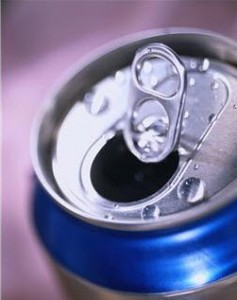 It’s estimated that we drink one-third of our daily calorie intake. When you see a 64-ounce soda or a coffee drink filled with whipped cream, it’s not a stretch to see how it can add up. But more than the calories, many of our beverage choices pose concerns about fat, sugar, and other undesirable ingredients.
It’s estimated that we drink one-third of our daily calorie intake. When you see a 64-ounce soda or a coffee drink filled with whipped cream, it’s not a stretch to see how it can add up. But more than the calories, many of our beverage choices pose concerns about fat, sugar, and other undesirable ingredients.
We already talked about soda and it’s concerns, which go way beyond just sugar. In this article, we are going to look at how you can make some healthy drink choices, at home or on the go.
Coffee
The most common beverage I am asked about without question is coffee. There is much conflicting information about coffee and part of the reason stems from the fact that we consume so much of it. Most things in moderation are typically ok; it’s when we are drinking pots instead of cups that concerns arise. In the case of coffee, a cup or two a day is more than ok.
Numerous studies have shown that coffee contains many health benefits including lowering your blood glucose levels, potentially increasing your metabolic activity, and lowering your risk for numerous conditions including dementia, stroke, cancers of the liver kidney and prostate, Parkinson’s disease and type 2 diabetes.
Coffee contains polyphenol antioxidants, bioflavanoids, vitamins and minerals that somehow together neutralize the potential harm of caffeine. That, however, does not mean there is no caffeine impact. While studies are not conclusive on how much is too much, most agree that a cup or two a day will do no harm and could do great good. But if you are addicted to coffee, can’t function without it, require several cups just to keep going, then it’s time to look at weaning yourself away from it and enjoying it purely for the flavor and not for the stimulation.
If you want to lower your caffeine consumption without reducing your cups per day, one way to do that without going cold turkey on coffee is to start mixing some decaf into your coffee and week after week, increase the ratio until you finally get down to a caffeine-free cup.
And of course, saying coffee has health benefits presumes that you’re not adding tons of sugar to it or adding hormone-laden milk to it. Choose pesticide-free beans, organically grown when possible, and keep in mind that much like chocolate, the darker the better: dark roast beans have more health benefits and less caffeine than lighter roast beans. So watch the add-ins, but otherwise, enjoy your coffee!
Tea
Ancient cultures from Africa to South America to Asia all have traditions steeped in their local tea brews. Tea has less caffeine than coffee, but still contains antioxidants and polyphenols that have numerous health benefits. Tea may well be the best thing you are not drinking… or not drinking enough of. In fact there is so much to tell you about tea that I’ve decided to put it all into another newsletter.
For now, try exploring the world of tea. Hot, it makes a soothing pick me up, and cold, a refreshing one. Tea bags are easy to keep in a desk drawer and if your office doesn’t have a kitchen, you can get cordless kettles now that heat up your water in minutes so you can enjoy at your desk. (Or you can make some in the morning and put it in a Thermos, let it cool and pour it over ice for iced tea at your desk anytime.) As with coffee, try not to add sugar. If you must add sweetener, consider Stevia or a little raw honey and over time, try to add less and less until you no longer need it.
Water
We all now we need to drink more water, but the challenge today is finding good clean water without chemicals such as fluoride. Despite the fact that ingesting fluoride comes with a warning to call poison control, for some inexplicable reason, many water supplies still contain it. If you have a good filtration system or are on a well that’s tested clean, the more water you can work into your day, the better. I know it’s not sexy, but a squeeze of lime or lemon can brighten it up.
If you haven’t invested in a water filter yet and are wondering whether tap is better than bottled, there are a number of considerations that make this a tough one to call. We are going to delve into the tradeoffs in depth in an upcoming newsletter and answer that question. For now, the easy answer is to consider a good water filtration system.
Before we leave water, I do want to mention seltzer. Seltzer has the same concerns of plastic bottling (which leaches chemicals especially when it’s exposed to heat) that bottled water raises, so it is not without health considerations. However, for those looking to drink more water and just need some sizzle to make it sexier, or for those trying to ease off their soda consumption, seltzer can be a good interim bridge.
If you received one of those soda makers as a gift, use it to make your own seltzer instead. As with most things, moderation is key: enjoying an occasional glass or two to boost your hydration and avoid soda is ok; drinking several liters a day may not be the best choice due to the excess carbonation.
Coconut Water
Another form of water that I can wholeheartedly endorse is coconut water. I discussed its benefits back in the newsletter about the power of coconut; coconut water is a great healthy drink option. It contains vitamins (especially the B vitamins), minerals and trace elements such as zinc, manganese, and selenium.
Coconut water is rich in electrolytes, making it a great natural and healthy alternative to the sugary sports drinks full of dyes and additives. Coconut water also contains amino acids, antioxidants, phytonutrients and cytokinins, which have been shown to be anti-again and cancer preventing.
Coconut water has been shown not just to rehydrate you but also to improve exercise performance. It is a heart protector as it helps regulate blood pressure, reduce plaque formation, and prevent abnormal blood clotting. It has also been shown to help prevent osteoporosis, cancer, reduce inflammation, and balance blood glucose and insulin levels. All this from a yummy drink that is low in calories and sugar, and also has an alkalizing effect on the body, helping to mitigate the highly acidic diets we tend to eat today. While it tastes sweet, it has about one-fifth of the sugar of typical fruit juices kids consume such as apple or grape and it has some fiber to moderate sugar absorption.
We love coconut water in my house, for all the wonderful health benefits as well as the taste. We use Zico brand as it was the only leading brand tested that contained the amount of nutrients it claimed to.
Juice
Most everyone knows by now that typical bottles or cartons of juice contain a lot of sugar without the fiber of the whole fruit. Because of that, juice should be avoided or consumed only in moderation. If you must have juice as part of your breakfast or daily routine, invest in the old-fashioned juice glasses our parents and grandparents used that will limit your serving size to six ounces or less.
Never drink juice without eating some protein and fiber along with it to moderate the sugar spiking. Choose berries and vegetables for your juice base when possible and read the label to be sure you are getting 100% pomegranate or blueberry juices, for example, and not a small amount mixed in with cheaper and sweeter apple or grape juice.
If you do consume apple or grape juice, keep in mind that they are made from the same fruits that were rated as the most heavily pesticide ridden by the Environmental Working Group. So if that is your juice of choice, look for organic: especially important if you are feeding it to children.
If you make your own juice, choose a juicer such as a Vitamix that includes the whole fruit and doesn’t extract the pulp, leaving the fiber in the trashcan. And if you choose to mix it in a smoothie, pay close attention to the other ingredients as well as the amount of fruit. Many smoothies begin with a base of a fruit juice high in sugar to which sweetened yogurt and extra fruit is added: all resulting in a big sugar rush.
Fruit is high in sugar, and while it contains wonderful other nutrients that make it well-worth including in our diets, drinking the equivalent of multiple pieces of fruit is still consuming a lot of sugar all at once. Be sure to include protein and fiber to mitigate the impact of the sugar: consider adding vegetables, especially dark green leafy ones to your smoothie, along with unsweetened Greek yogurt or raw milk protein powder.
My son cannot live without orange juice in the morning. So to make it a healthier option, we add a raw milk protein powder called Whey Cool along with a scoop of Boku, a Superfood powder made from organic whole food and lots of greens. He gets his juice, but it’s delivered in a nutritionally dense powerhouse of vitamins, minerals and antioxidants, so I can feel good about it.
Kefir
This one may take some getting used to, but kefir is a drink that delivers all the benefits of yogurt, and more. Like yogurt, kefir is made by fermenting milk with bacteria, resulting in probiotics that support a healthy digestive tract. But kefir is fermented with different types of bacteria, and more of them, resulting in even greater health benefits than yogurt.
Kefir has been shown to help lower blood pressure and cholesterol, as well as restore balance to your digestive system, relieve intestinal disorders, and it even claims to reduce food cravings and ADHD. (Eating a healthy balanced diet would do so, so seeing that result after adding nutrient rich kefir would make sense.)
Kefir supplies complete protein, B vitamins and essential minerals. Many people who are lactose intolerant can even digest it. Kefir is a nutritional powerhouse but it does have a sour taste. Some people love the taste and have no trouble digesting it. Others need to build their tolerance for both more gradually. In that case, start with 4 ounces on an empty stomach in the morning and build up slowly adding a little more over time.
If you are a smoothie drinker, try adding it to your smoothie where the sweetness of the fruit will counteract the bitterness but you’ll still get vitamins, minerals and probiotic effects beyond what you can get from yogurt. I confess I struggle with the taste but it is slowly growing on me. Even though my kids are both from the area of the world where kefir is a daily household beverage, it’s still growing on them too. But I look for ways to use it in other things when possible and sneak it in.
You can buy kefir in most grocery and natural food stores, or it’s actually easy to make your own if you prefer. If you’ve never tried it, you should at least give it a try. If you can tolerate a little, keep adding a bit more every day. If not, use it in a smoothie or a dip or something else you could use drinkable yogurt in. But it’s definitely worth checking out for all its health benefits.
To your wellness and health: your true wealth!
Inger
Author: Inger Pols is the Editor of the New England Health Advisory and Author/Creator, Finally Make It Happen, the proven process to get what you want. Get a free special report on The Truth About Sugar: It’s Not All Equal at www.IngerPols.com
Photo Source: Microsoft Clip Art

 I’ve received many emails asking for guidance around healthy drink choices. Since studies show people drink one-third of their daily calories, and many beverages contain harmful ingredients while others contain health benefits, it’s important to have the information to sift through the options and make the best choices.
I’ve received many emails asking for guidance around healthy drink choices. Since studies show people drink one-third of their daily calories, and many beverages contain harmful ingredients while others contain health benefits, it’s important to have the information to sift through the options and make the best choices. Greetings from India! I spent some time around Delhi, saw the Taj Mahal, and am now on my way to Rishikesh, a beautiful town in the Himalayas along the banks of the Ganges, for the International Yoga Festival. This newsletter will be short and will include a few tips until I can write more. If I have internet access, I’ll post on the New England Health Advisory Facebook page while I’m there!
Greetings from India! I spent some time around Delhi, saw the Taj Mahal, and am now on my way to Rishikesh, a beautiful town in the Himalayas along the banks of the Ganges, for the International Yoga Festival. This newsletter will be short and will include a few tips until I can write more. If I have internet access, I’ll post on the New England Health Advisory Facebook page while I’m there!

 Follow me on Twitter
Follow me on Twitter 